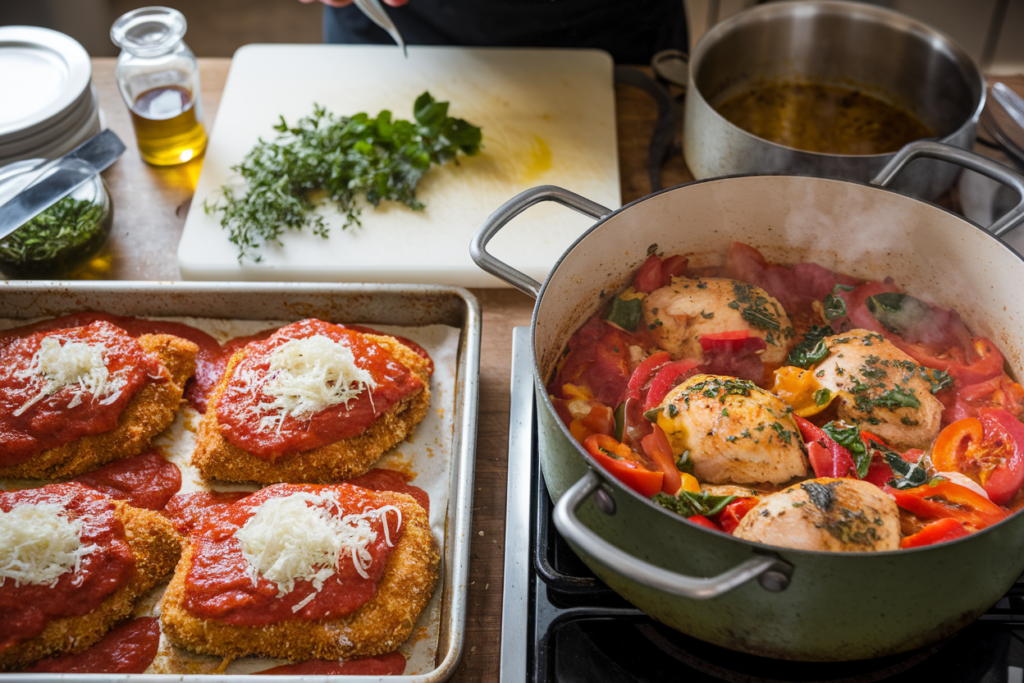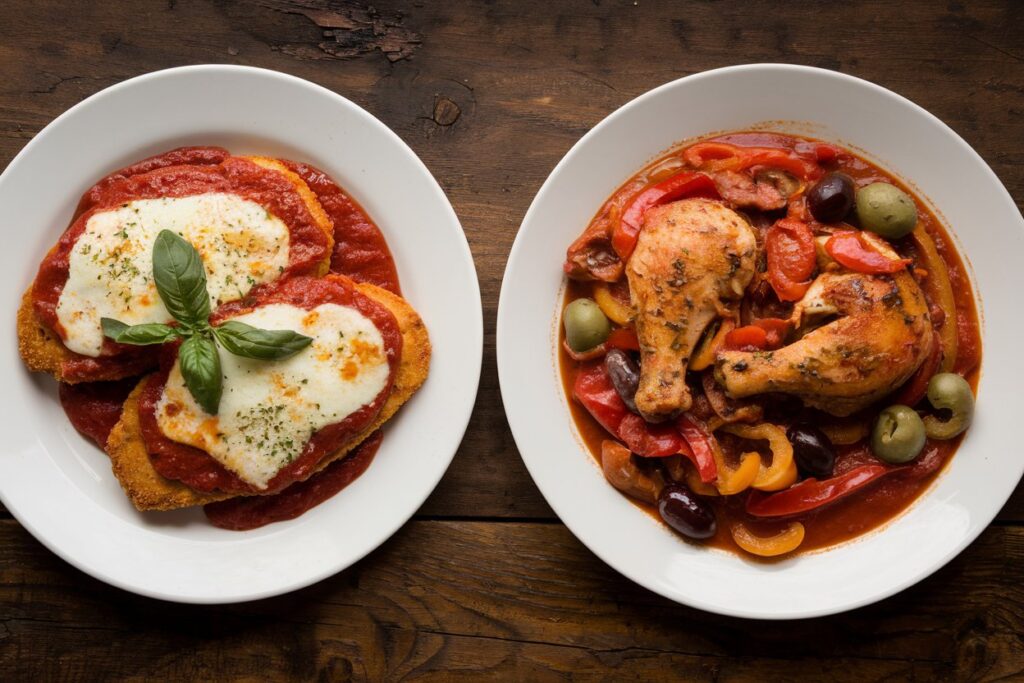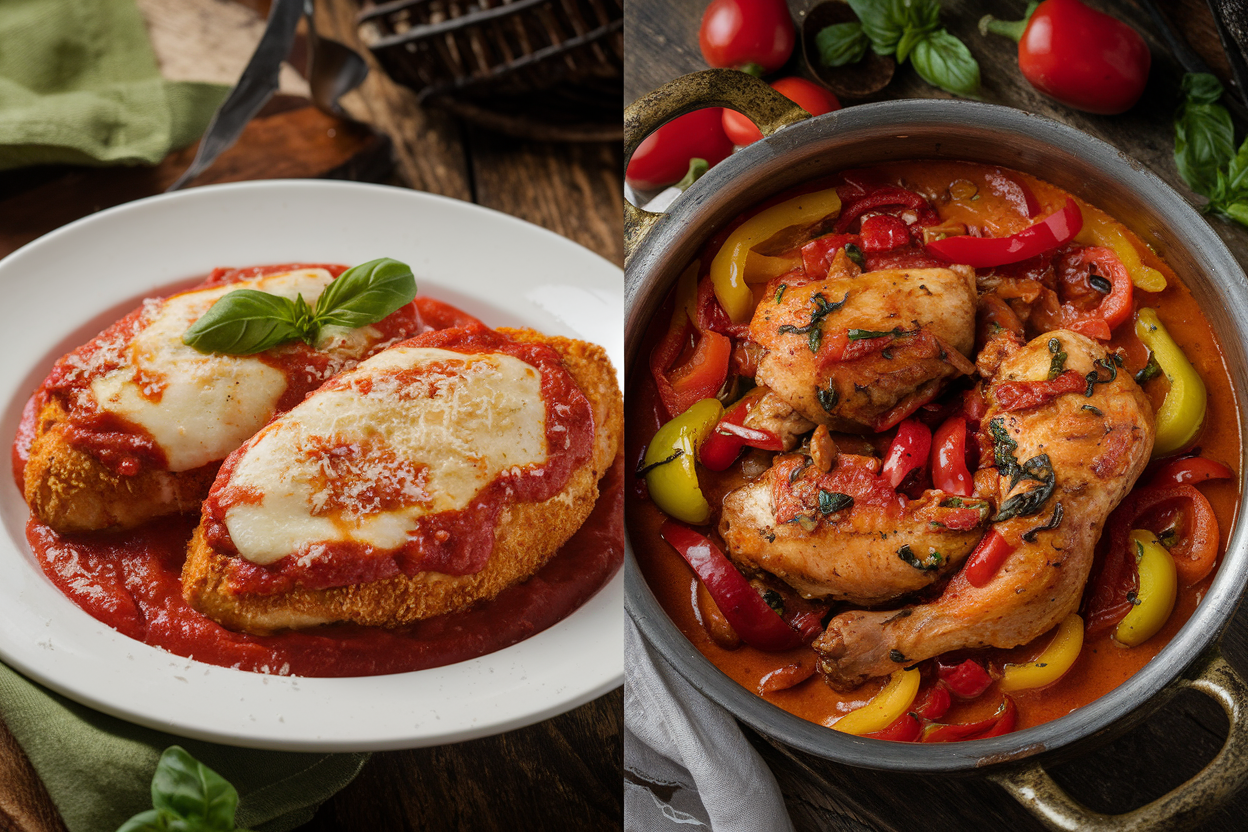Introduction to Italian Cuisine
Italian cuisine has captured the hearts and taste buds of people worldwide. With its rich flavors and use of fresh ingredients, it’s no surprise that many households love dishes like Chicken Parmesan and Chicken Cacciatore. These dishes have distinct origins and preparation methods, but what sets them apart? This article explores the key differences between these two classic Italian dishes.
Overview: Distinguishing Between These Two Italian Favorites
Both Chicken Parmesan and Chicken Cacciatore are Italian-inspired chicken dishes, each with unique characteristics that set them apart. Chicken Parmesan often appears in Italian-American cuisine, while Chicken Cacciatore has roots in traditional Italian cooking. By understanding the nuances of each dish, we can better appreciate Italian cuisine and recreate these dishes authentically at home.
To dive deeper into variations of Chicken Parmesan, you might also want to explore the nuances in Chicken Parmesan and Parmigiana.
What is Chicken Parmesan?
Origins and History: The Rise of a Classic Italian-American Favorite
Chicken Parmesan, also known as Chicken Parmigiana, is a popular dish that combines breaded chicken cutlets, marinara sauce, and a generous topping of mozzarella and Parmesan cheese. Its origins can be traced back to Italian immigrants in the United States, who adapted traditional Italian recipes to suit local tastes. This adaptation resulted in a dish that has become a staple in Italian-American cuisine.
Originally, similar dishes were made with eggplant in Italy, known as Melanzane alla Parmigiana. The switch to chicken as a primary ingredient likely occurred in the United States, where meat was more readily available and affordable. This adaptation has led to numerous variations of the dish, each with its own regional twist.
Key Ingredients in Chicken Parmesan
- Chicken: Boneless, skinless chicken breasts are most commonly used, but some variations use chicken thighs for added flavor.
- Bread Crumbs: Both seasoned and plain bread crumbs can be used. Panko bread crumbs are popular for their extra crunch.
- Cheese: A mixture of mozzarella and Parmesan cheese gives the dish its signature creamy and salty taste.
- Marinara Sauce: A simple sauce made from tomatoes, garlic, and herbs. Some variations include additional spices or even a touch of sugar.
- Olive Oil or Butter: Used for frying the breaded chicken, adding a rich flavor.
Variations may include using different types of cheese, such as provolone or adding herbs and spices to the breading to enhance the flavor.
For those interested in how to handle chicken for various recipes, including Chicken Parmesan, check out these tips on thin-sliced chicken breast recipes.
How to Prepare Chicken Parmesan
- Bread the Chicken: Start by dipping the chicken breasts in beaten eggs, then coat them with a mixture of bread crumbs and Parmesan cheese. This step is crucial for achieving the signature crispy crust.
- Fry the Chicken: Heat olive oil in a skillet over medium heat. Fry the breaded chicken until golden brown on both sides. This creates a crispy exterior that contrasts beautifully with the soft interior.
- Bake with Cheese: Place the fried chicken in a baking dish, top with marinara sauce, mozzarella, and more Parmesan cheese. Bake in a preheated oven at 375°F (190°C) until the cheese is melted and bubbly.
People often serve Chicken Parmesan with pasta, such as spaghetti or linguine, or with a side salad, making it a hearty and satisfying meal. Some variations include serving the dish on a sandwich, known as a Chicken Parmesan sub or hoagie.
Nutritional Information and Dietary Considerations for Chicken Parmesan
- Calories: Chicken Parmesan can be high in calories, especially due to the breading and frying process. A typical serving can range from 400 to 600 calories.
- Protein: The dish is a good source of protein, with chicken providing lean protein essential for muscle growth and repair.
- Fat: Contains significant amounts of fat due to the frying and cheese. Using lower-fat cheese options or baking the chicken can reduce fat content.
- Carbohydrates: The breading and any accompanying pasta add carbohydrates to the dish. Using whole grain pasta can increase fiber content.
For those following a specific diet, such as low-carb or gluten-free, adjustments can be made by using almond flour for breading and serving the chicken with vegetables instead of pasta.
What is Chicken Cacciatore?
Origins and History of Chicken Cacciatore: The Hunter’s Chicken
Chicken Cacciatore means “hunter-style” chicken in Italian. This rustic dish traditionally includes chicken pieces cooked in a savory sauce made with tomatoes, onions, peppers, herbs, and sometimes wine. It’s a hearty, one-pot meal that reflects the simplicity and resourcefulness of Italian peasant cooking.
The term “cacciatore” means “hunter” in Italian, and the dish was originally made with whatever the hunter could find—often rabbit or game birds. Chicken became the more popular meat for this dish over time, especially in home kitchens.
For a taste of authenticity, explore this Classic Chicken Cacciatore Recipe.
Essential Ingredients in Chicken Cacciatore
- Chicken: Use bone-in chicken pieces such as thighs, legs, or even a whole chicken cut into parts. The bones enhance the flavor and richness of the dish.
- Tomatoes: Incorporate both fresh and canned tomatoes. As they cook, the tomatoes break down, creating a rich, flavorful sauce.
- Bell Peppers: Add red and green bell peppers for sweetness and color.
- Onions and Garlic: These essential aromatics form the base of the sauce.
- Herbs: Commonly use fresh herbs like rosemary, thyme, or oregano. Bay leaves and basil can also be added.
- Wine: Red or white wine is often used to deglaze the pan and add depth to the sauce. The alcohol evaporates during cooking, leaving behind a rich flavor.
Some variations might include mushrooms, olives, or capers, depending on regional preferences. Each ingredient adds to the complexity of the dish.y, making it a favorite among those who enjoy bold, hearty flavors.
How to Cook Chicken Cacciatore: A Step-by-Step Guide
- Sauté the Vegetables: In a large pot or skillet, sauté onions, garlic, and bell peppers in olive oil until softened. This step releases the aromatics and builds the flavor base for the sauce.
- Brown the Chicken: Add the chicken pieces and brown them on all sides. Browning the chicken helps to lock in moisture and flavor.
- Simmer the Sauce: Add tomatoes, herbs, and wine to the pot. Cover and simmer on low heat for about 30-40 minutes, or until the chicken is cooked through and tender. The sauce should thicken and develop a rich, deep flavor as it cooks.
Chicken Cacciatore is typically served with rustic bread, polenta, or pasta, soaking up the rich sauce. It’s a dish that improves with time, often tasting even better the next day as the flavors meld together.
Nutritional Information and Dietary Considerations for Chicken Cacciatore
- Calories: Lower in calories compared to Chicken Parmesan, especially if made without wine. A typical serving ranges from 300 to 400 calories.
- Protein: A good source of lean protein from the chicken.
- Fat: Contains healthy fats from olive oil. Removing the skin from the chicken can further reduce fat content.
- Vitamins and Minerals: Rich in vitamins A and C from the tomatoes and peppers, as well as potassium and iron.
Suitable for various diets, Chicken Cacciatore is naturally low-carb and gluten-free, making it an excellent choice for those following these dietary patterns. It can also be adapted for a paleo diet by ensuring all ingredients are compliant.
Comparing These Classic Italian Chicken Dishes

Flavor Profile Differences Between Chicken Parmesan and Chicken Cacciatore
- Chicken Parmesan: This dish is characterized by its rich, cheesy, and savory flavors. The combination of crispy breaded chicken with tangy marinara sauce and melted cheese creates a satisfying taste and texture. The cheese provides a creamy contrast to the acidic tomato sauce.
- Chicken Cacciatore: In contrast, Chicken Cacciatore has an earthy and aromatic flavor profile. The slow-cooked tomato sauce is infused with herbs and wine, offering a deeper, more complex taste. The use of bell peppers adds a touch of sweetness, balancing the acidity of the tomatoes.
These distinct flavors mean that each dish can cater to different palates—one being more indulgent and comforting, the other robust and hearty.
Cooking Techniques: Chicken Parmesan vs. Chicken Cacciatore
- Chicken Parmesan: Involves breading and frying chicken, then baking it with cheese and sauce. This method gives the dish its signature crispy texture and gooey cheese topping.
- Chicken Cacciatore: A one-pot dish that involves sautéing and slow-cooking, which allows the flavors to develop over time. The longer cooking time results in tender chicken that falls off the bone, enveloped in a rich, flavorful sauce.
Both dishes require different levels of preparation and cooking time, making them suitable for different occasions. Chicken Parmesan might be quicker and ideal for a weeknight meal, while Chicken Cacciatore is perfect for a leisurely weekend dinner.
Serving Suggestions and Accompaniments for Chicken Parmesan and Chicken Cacciatore
- Chicken Parmesan: Typically served with pasta, a side of garlic bread, or a fresh green salad. The simplicity of the sides allows the dish’s flavors to shine.
- Chicken Cacciatore: Best paired with crusty bread, polenta, or over a bed of rice or pasta. These accompaniments help soak up the delicious sauce, making for a comforting and satisfying meal.
Experimenting with different sides can provide new dining experiences with these classic dishes, each complementing their unique flavor profiles.
Cultural and Regional Significance

Regional Popularity: Chicken Parmesan and Chicken Cacciatore Around the World
In the United States, Chicken Parmesan is a favorite at Italian-American restaurants and is often seen on family dinner tables. It represents the blending of Italian culinary traditions with American tastes, often appearing on menus alongside other Italian-American classics like lasagna and spaghetti with meatballs.
In contrast, Chicken Cacciatore remains closer to its Italian roots, popular in regions of Italy where rustic, home-cooked meals are cherished. It reflects the Italian approach to cooking—simple, hearty, and based on fresh, local ingredients. Each region of Italy may have its own version of Cacciatore, depending on what ingredients are available locally.
Symbolic Meaning and Cultural Impact of These Iconic Dishes
Both dishes symbolize the blending of Italian and American culinary traditions. Chicken Parmesan represents the evolution of Italian cuisine in America, where ingredients like Parmesan and mozzarella became more accessible, leading to their widespread use in various dishes. The dish also showcases the Italian-American tradition of making meals that are hearty, comforting, and perfect for family gatherings.
Chicken Cacciatore remains a testament to the simplicity and resourcefulness of traditional Italian cooking. It reflects the Italian way of making the most of what is available, turning simple ingredients into a meal that is both delicious and nourishing. This dish is a reminder of the rustic roots of Italian cuisine and the importance of tradition in culinary practices.
FAQs: Common Questions About These Popular Italian Dishes
- Is Chicken Parmesan the same as Chicken Parmigiana?
- Chicken Parmesan and Chicken Parmigiana refer to the same dish. In some regions, people use the term “Parmigiana” to emphasize the inclusion of Parmesan cheese.
- Can Chicken Cacciatore be made with other meats?
- Absolutely! Chicken Cacciatore can be made with rabbit, pork, or even a mix of meats. Each type of meat adds its own unique flavor to the dish, making it versatile and adaptable.
- What is the best way to reheat Chicken Parmesan?
- To keep it crispy, reheat Chicken Parmesan in an oven rather than a microwave. This helps maintain the texture of the breaded chicken and prevents the cheese from becoming rubbery.
- How do you store leftovers of Chicken Cacciatore?
- Store in an airtight container in the fridge for up to 3 days or freeze for longer storage. When reheating, add a splash of water or broth to the sauce to refresh its flavor and consistency.
- Can these dishes be made vegetarian?
- Yes, both dishes can be adapted with plant-based proteins like eggplant or tofu. For a vegetarian version of Chicken Parmesan, use breaded eggplant slices instead of chicken. For Chicken Cacciatore, tofu or mushrooms can provide a similar texture and absorb the flavors of the sauce.
Conclusion: Understanding the Unique Traits of Each Dish
Chicken Parmesan and Chicken Cacciatore are both beloved dishes in their own right, each offering unique flavors and cooking methods. Whether you prefer the cheesy, crispy satisfaction of Chicken Parmesan or the hearty, comforting warmth of Chicken Cacciatore, both dishes showcase the versatility and richness of Italian cuisine. With their distinct ingredients and preparation styles, they offer delicious options for every palate and occasion.
By utilizing internal links such as thin-sliced chicken breast recipes and understanding variations between Chicken Parmesan and Parmigiana, readers can explore related topics that enhance their culinary knowledge and skills. Additionally, learning about how long to brine chicken can further improve the preparation of these classic dishes, ensuring a moist and flavorful outcome every time.
